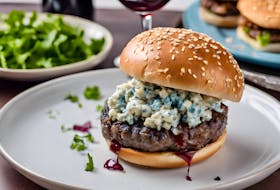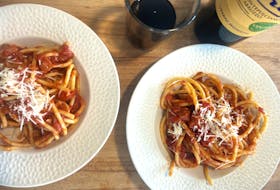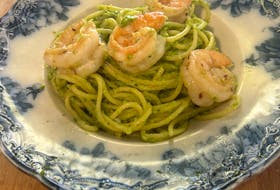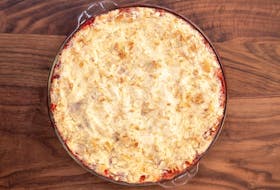Our cookbook of the week is Carpathia: Food from the Heart of Romania by Irina Georgescu. To try a recipe from the book, check out: Alivenci (Moldovan polenta cakes with cheese and dill), papanaşi (ricotta doughnuts served with sour cherry jam and crème fraîche) and prǎjitura cu caise (apricot yogurt cake).
Layer upon layer of sponge cake and chocolate buttercream — seven to be exact — doboş tort is a walnut-crusted relic of the Austro-Hungarian Empire. Growing up in Romania, a pared-down version of the rich dessert was author Irina Georgescu ’s birthday cake of choice.
Her mother, Lucia — who worked in IT for the army — kept a cache of secret recipes in an old chocolate box. Doboş tort was among them, scrawled on the back of a receipt from a shoe repair shop. It listed the method for the buttercream filling and, “Make the layers for the cake.” No further explanation needed.
“She knew that they were standard — what we call génoise today. So she just said, ‘Layers for the cake,’ that was all. Many people did the same because during communism we were reduced to a cookery book or two … and no ingredients. ‘Just keep it, read it and imagine it,’” says Georgescu, laughing.
With limited sanctioned cooking inspiration, she recalls, “a black market for recipes” sprung up to fill the void. Jotted down on napkins or scraps of paper, these surreptitious documents became culinary ephemera for future generations. “People, through word of mouth, managed to keep some traditions alive,” Georgescu adds, “and some sort of regional cookery alive.”
In writing her debut book, Carpathia (Interlink Books, 2020), Georgescu made an effort to stay true to the way her mother cooked. Drawing on memories of being at her side in the kitchen and at the market, she set out to represent the classics; traditional Romanian dishes with some adjustments reflecting how she cooks and eats today, in the U.K.
Mothers, she writes, are the “culinary bibles” of Romania. As a result, cooking is intensely individual and your own mother’s way of doing things is hard, if not impossible, to beat. “We’re very much Italians from this point of view. It’s like, ‘No, my mom cooks the best recipe.’ Everything is very personal, and that’s why our mothers are our bibles. We go to them all the time and say, ‘What should we do here?’ ‘How do you do it?’ ‘Oh mom, I ruined this,’” says Georgescu.
“When my mom was alive, I was able to show her on Skype, ‘Mom, look. I did this!’ It was quite something to connect like that. But when I was writing the book, she wasn’t there anymore. It’s very sad because when she had time, I wasn’t in the right mindset. And when I had time, she didn’t have time. So I tried to remember and talk to my sister about it, just to stay close to her way of doing things.”
Very few English-language cookbooks have focused on Romanian cuisine, but as Georgescu illustrates, it has much to offer the uninitiated. Convivial and generous, starters such as eggplant caviar, cheesy polenta and charcuterie are shared mezze-style. Braided breads, cultured dairy-enriched baked goods and tangy borș (a fermented ingredient used to make sour broth, which is so integral she devotes a chapter to it) are satisfyingly homey.
“A culinary melting pot,” the Eastern European nation’s fascinating history is reflected in its cuisine. Centuries of invasions, occupations and cultural exchanges can still be seen on tables today. And while Romanian food culture shares traits with its neighbours, it has unique expressions shaped by terroir and local customs.
In past years, authors have forged a “new culinary map of Eastern Europe through food,” says Georgescu. Cookbooks focusing on other Eastern European regions — the Baltics ( Baltic ), the Caucasus ( Kaukasis , Lavash , Supra , Taste of Persia , The Georgian Feast ), Poland ( Polska , Rose Petal Jam , Wild Honey & Rye ), Russia ( Beyond the North Wind , Kachka , Salt & Time ) and Ukraine ( Mamushka ) — have resulted in a deeper understanding and appreciation in the West. But until Carpathia , the cuisine of Romania hadn’t been charted in the same way.
“Romania is completely skipped. You cross from Poland to Russia, and to Ukraine … But actually in the middle, it’s us. We’re here! I’m waving,” says Georgescu with a laugh. There are threads connecting the food of the region, she emphasizes, adding that it’s impossible to identify any dish as belonging to just one country. In Romania, you’ll find dishes with roots in Austria, Germany, Greece, Hungary, Slavic countries (such as Poland, Serbia and Ukraine) and Turkey.
“You can’t say that only the Ukrainians eat filled dumplings (for example), because we do the same and Polish people do the same. There’s a lot of common culinary heritage here, but it doesn’t mean that Romanians don’t use their own ingredients to create their own dishes. This is what I wanted to do (with Carpathia ). To say, ‘Yes, I’m here. Yes, I eat probably exactly like you, but we have our own story to tell.’”
Copyright Postmedia Network Inc., 2020








